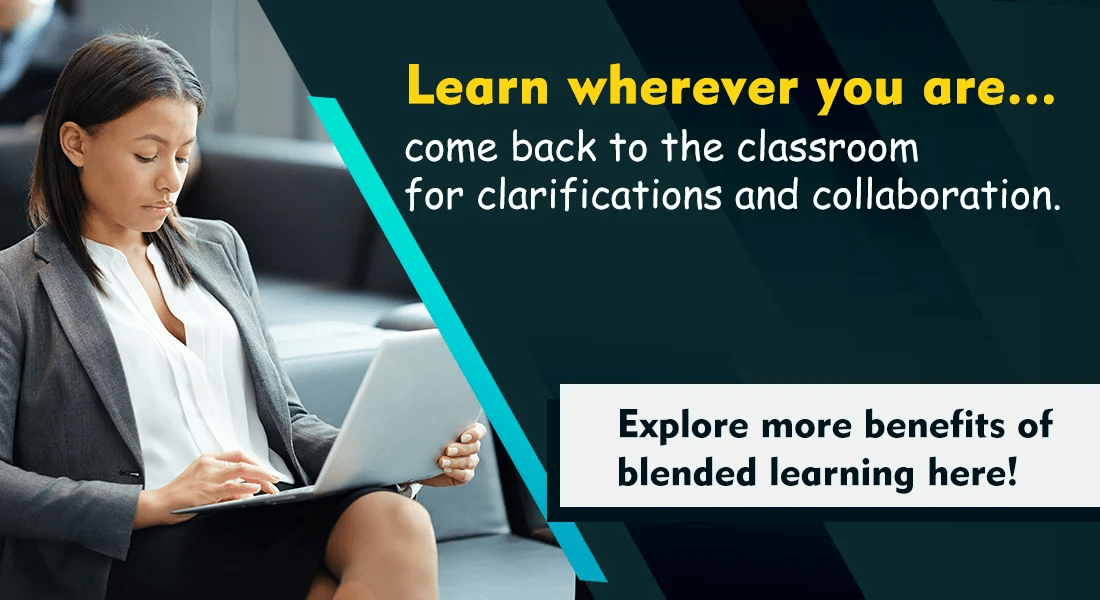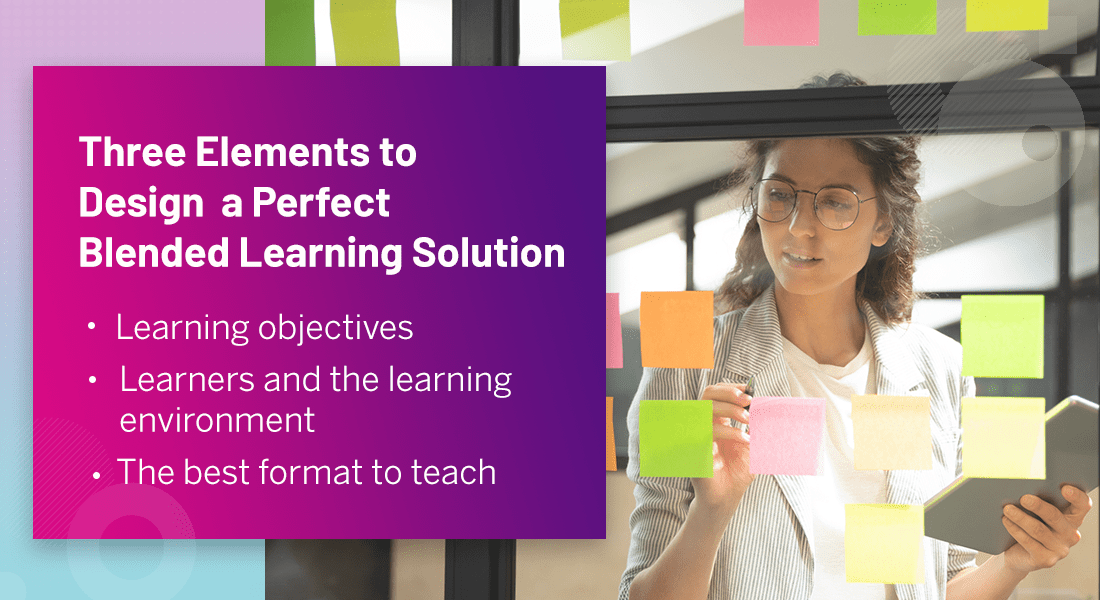Blended Learning: The Key to Effective Corporate Training

In recent years, the term blended learning has become a buzzword in the business world. Blended learning mixes the finest of traditional classroom training with newer methods, such as microlearning, VILT and inventive eLearning courses. To engage all kinds of learners, it’s important to cover all the bases. This includes those who learn best in an in person, structured space and those who learn best in a semi-autonomous, virtual environment.
Picking up New Skills is Far More Flexible Through Blended Learning Than Through Conventional Techniques
The benefits of blended learning are:
- Learning Flexibility
- Safer Learning Spaces
- Reinforced Retention
- Pace of Learning
- Cost-efficient
- Timesaving
- Modular and Scalable
While eLearning is crucial to reskill and upskill the workforce, it might lack the interactivity that employee’s access through traditional training approaches. Equally, frequent in-person training sessions aren’t always cost-effective because of variances in the learners’ personalities, skill levels, and pace of learning. It can be challenging to meet the needs of remote and hybrid workplaces by conducting eLearning courses and online training sessions. Here, the blended learning technique comes in handy. It takes a hybrid route for L&D professionals.
What is Blended Learning?
Blended learning is a training paradigm that offers continuous learning in today’s corporate training space. To satisfy the increasing demands of trainees, workers, employers, trainers, and learning professionals, blended learning mixes conventional face-to-face learning in a classroom environment with online learning. Essentially, blended learning expands learning beyond known parameters by allowing learners 24/7 access to both online and offline content, accessible at any time and from any location.
Blended Learning Helps Accelerate Time to Proficiency. Explore how!
Formats of Blended Learning
Empowered by the latest digital formats, online learners can now decide where, how, and what they intend to learn while following a convenient schedule.
Much of the workforce is now operating remotely. Enabling them to choose their own format enhances their learning efficiency. You can train your employees even more effectively using blended learning solutions. When you offer a variety of blended learning formats it guarantees that learners are immersed in the content. With a variety of formats to select from, blended learning gives learners the best of both the online and offline worlds.
Now, the question remains. What are these blended learning formats that a learner can choose from? To answer this, let’s segment the blended learning formats into face-to-face, social, virtual collaboration, self-directed learning, and Electronic Performance Support Systems (EPSS).
Face-to-Face Formats
ILT
Instructor-led training is an in-person training method in which a trainer or facilitator leads a group of learners through a session. Trainers are often subject-matter specialists, while facilitators are not.
VILT
or virtual instructor-led training, allows instructors to move the classroom to an online platform using video conferencing applications like Skype, Microsoft Teams, and Google Meet. It keeps the real-time and synchronous aspects of instructor-led training and removes in-person interaction.
On-the-Job Training
On-the-job training is a practical technique to learn new skills and abilities in the real world. It’s often utilized in the actionable, simulated, or training opportunities where learners grow in their knowledge of let’s say handling software tools and workplace equipment.
Workshop Training
A workshop is a standalone training event that lasts anywhere from an hour to several days. Trainers use workshops when they want to educate or expose participants to practical skills, methods, or concepts that they use in their job and everyday tasks.
Social Formats
Discussion Boards
Instructor-to-learner and learner-to-learners interaction are possible through a discussion board. Learners from all around the world socialize and learn from each other. Discussion boards promote collaborative learning, which adds distinction to your training.
Online Forums
Online discussion forums are online spaces where people indulge in conversations through posted messages.
Virtual Collaboration
Trainers’ schedule synchronous virtual collaborations, real-time interactions through the phone, video, and engaging online formats.
VILT Mentoring provides trainees the opportunity to have virtual interactions with a mentor, either one-on-one or in a small group. The principal purpose of mentoring covers the activities that support the trainee’s academic and professional goals.
Virtual Collaboration: Asynchronous
Collaboration over emails help learners exchange knowledge, ask questions, and share resources at times that are convenient for both trainees and instructors.
Bulletin Boards
Bulletin boards can be brick and mortar as well as online. They are excellent channels to impart new information with, and they keep trainees posted about developments and emerging facts.
Online Communities
Online communities are effective ways to foster meaningful interactions among learners through a multitude of communication technologies. This way, they can discuss concepts and engage with SMEs and their course facilitators.
Self-Directed Learning
Web-based Modules
Web-based modules combine a variety of software technologies to cater for a wide range of trainer and learner needs through the Internet. These tools improve face-to-face training and offer virtual learning courses.
Online Resource Links
A resource page on a website is a page that contains useful links and resources for distinct topics.
Simulations
L&D teams utilize simulators in corporate training frequently to present game-based learning goals. Companies that include gamification with their training programs are strengthening their workers’ latent skills.
Online Simulation
Employees gain skills through virtual learning in a safe, risk-free, and efficient environment using simulators.
Scenarios
Scenario-based learning is an effective method that employs immersive simulations such as virtual reality environments, eLearning games, microlearning quizzes, role-plays, and similar tools to help workers apply their knowledge and skills in real-life.
Workbooks
Workbooks add value and act as sources for future reference. They help instructors assess what trainees have learned through various, engaging exercises.
EPSS (Electronic Performance Support Systems)
Support Systems
An EPSS support system serves as a coach for the learner, helping them through a procedure. You can use an EPSS along with classroom learning or in place of formal training.
Job Aids
Job aids are short, yet straightforward manuals that help you complete a task at work. A few examples include, cheat sheets, one-pagers, memory joggers, productivity enhancement tools, and regulatory lists.
Knowledge Databases
Allow facilitators to concentrate relevant training information and job-related resources in a single, readily accessible space. They also expedite the training of new workers and streamline the process of upskilling and reskilling at your company.
Instructional Videos
Businesses develop training videos to inform and communicate with their employees on new products and services, regulations and compliance guidelines, health & safety procedures, and skill development. A few examples of instructional videos are whiteboard and animated explainers, live-action animations, stock videos, screen cast and talking head films, and microlearning videos.
Mobile Applications
Mobile applications are used to train, and as a performance support tool or a microlearning nugget.
Performance Enhancement Instruments
Performance enhancement instruments assist instructors in determining how effectively your training is functioning and it provides them with tools to modify and enhance it. You can monitor a variety of assessment criteria, and the variables you use are determined by your training program. Learner engagement, learning outcomes, behavior changes, and performance gains are frequently used assessment indicators.
The Benefits of Blended Learning
Blended learning comes with a plethora of benefits. Let’s look at a few.
Learning Flexibility
Blended learning provides executives and employees with the flexibility to manage their learning schedules. Trainers use new-age communication technologies and storage options to exchange and deliver training material with their corporate trainees. They discuss core topics and clear doubts, answer questions, and provide much-needed training materials, such as videos, PDFs, and simulations.
Cloud-based LMSs (Learning Management Systems) have handed over the power of learning to employees by enabling learners access at anytime, anywhere, on any device, and at their own pace.
Safer Learning Spaces
The blended learning architecture uses technology to combine online courses with offline learning, so learners gain concepts and skills from the safety of their homes without losing the warmth of human interaction, for example through VILT.
Reinforced Retention
Recent studies show that mixing diverse, engaging activities with passive learning improves learners’ experiences. To exchange and compare information and motivate and showcase the efficient application of newly gained skills at work, your course should include human connections, such as threaded conversations, teleconferencing, and internal networking sites.
When you use various modes of delivery you close any information gaps left by inappropriate modes of delivery. You can utilize VILT for collaborative social learning, simulations for hands-on experience, and scenario-based learning to enhance critical thinking and decision-making skills.
Pace of Learning
Blended learning allows trainees the opportunity to learn at their own pace and in a safe environment. It provides the much-needed warmth of human connection. It gives learners the opportunity to communicate with experts in their fields not only to debate with and explain their problems to, but to seek inspiration in the face of self-doubt and uncertainty.
Tablets and smartphones are popular sources of information. So, eLearning professionals must create mobile-friendly courses with responsive designs. Such courses enable on-the-go learning and foster greater engagement as well. Microlearning videos are bite-sized and are excellent at helping learners gain control of their schedule and learn at their pace, as well as work on the skills they want to enhance.
Cost-efficient
When you use blended learning, you can save money that you would spend on a traditional training program. The initial cost is a onetime investment. However, after that, you can build online courses for less. Corporates also save money on hiring personnel, booking venues, electricity, and travel. Experts develop eLearning and microlearning just once and use them to train exponential batches. These innovative strategies save time, enhance utility, and boost ROI (return on investment).
Timesaving
Blended learning effectively saves work hours lost in the facilitators and learner’s commute. Instead, employees spend these hours at work and add value. This way blended learning is beneficial and necessary.
Your employees have real-time access to training; giving them the capacity to learn at their pace. This helps your company stay relevant and productive. The practical advantages of blended learning include lower training costs and increased learning effectiveness.
Modular and Scalable
Blended learning is effective for large, multinational businesses since it’s modular and scalable both upward and downstream. When instructors set up and participate in traditional learning it consumes a lot of their time. So, it’s not cost-effective at the individual level.
“Modular courses increase agility and thereby the organization’s capacity to capitalize on new business opportunities as they arise.” Said eLearning designer Troy Foster.
It’s a Wrap
Corporate training has advanced to the point that it involves more than upskilling employees with technological skills and concepts. It’s also intended to assist people in improving their ability to nurture teams.
A blended environment integrates many forms of learning into one strong program that provides learners with a comprehensive, immersive learning experience. It’s easy to beat the forgetting curve and boost employee performance through this creative format. So, it’s an effective and vital training approach that you need to consider meeting your business goals. Are you ready for that? Download this eBook to learn how to utilize technology and increase employee performance by minimizing the time needed to train your learners.





